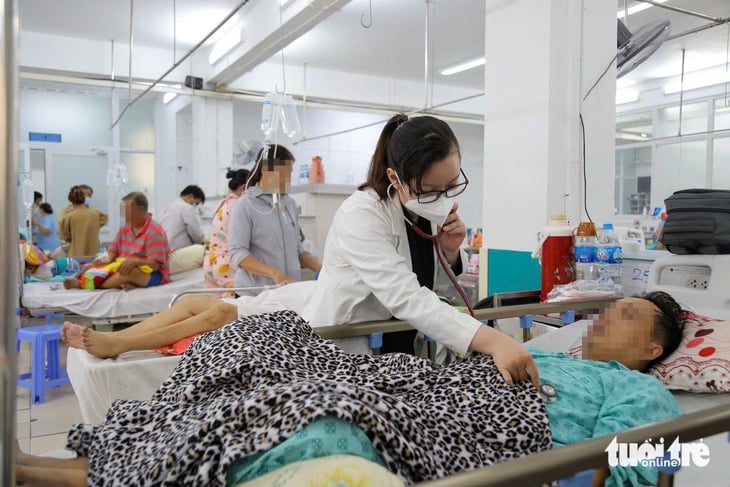Stroke patient being treated at the cerebrovascular disease department of People's Hospital 115 (HCMC) - Photo: PHUONG QUYEN
The average age of stroke in Vietnam is 62, in developed countries it is 70 - 75.
Associate Professor, Dr. Nguyen Huy Thang - Vice President of the Vietnam Stroke Association and Head of the Department of Cerebrovascular Diseases at People's Hospital 115 - has just announced that through statistics of 6,601 patients admitted to People's Hospital 115, the average age of stroke is 62.
Other data from 2,300 stroke patients through the ResQ registry (the first global registry study with the aim of improving the quality of stroke units - PV) in Vietnam also showed similar results.
The cerebrovascular disease department of People's Hospital 115 recently received 49 new stroke patients.
Of which, the age group under 65 accounts for nearly 50%, especially a female patient born in 2004.
According to data from reliable sources such as the World Health Organization (WHO), the US Centers for Disease Control and Prevention (CDC), and studies from Oxford University and Yale School of Medicine, the average age of stroke in the general population ranges from 70 to 75.
However, this number may vary depending on geographic region, gender, and risk factors.
"This means that the age of stroke in Vietnam is about 10 years lower than the figures in developed countries. In other words, stroke patients in Vietnam are getting younger," Associate Professor Thang concluded.
Associate Professor Thang added that women are more likely to have a stroke than men. The reason may be because women have a higher average life expectancy.
In addition, the rate of smoking and alcohol use in women is lower than in men.
"Naming" the causes
Not only in Vietnam, the increasing rate of stroke in young people in developing countries is a worrying issue, stemming from many different causes. Associate Professor Thang listed the main causes leading to this situation:
Hypertension and underlying medical conditions: Young people are increasingly facing diseases such as hypertension, diabetes, and dyslipidemia at an earlier age. This is mainly due to a sedentary lifestyle, unhealthy diet (high in fast food, low in vegetables), and obesity, which are becoming more common in the context of modernization.
Urbanization: Rapid urbanization in developing countries has changed the lifestyle of young people.
They are less physically active, consume more processed foods high in salt and sugar, and are under psychological stress from work and urban living. All of these are major risk factors for stroke.
Air pollution: In many major cities in developing countries, air pollution has reached alarming levels. regularly exposed to polluted environments. Recent studies suggest a link between environmental pollution and an increased risk of stroke.
Lack of access to health care: health systems in developing countries are often limited, with few screening programs for underlying conditions such as high blood pressure or diabetes. Failure to detect and treat risk factors early leaves young people vulnerable to stroke without prior preparation.
Smoking and substance use: Smoking, drinking and other drug use are rising among young people in developing countries. These habits damage blood vessels and increase the risk of stroke, especially when combined with other factors.
Genetic and ethnic factors: Some ethnic groups in developing countries have a higher risk of vascular disease due to genetic factors. When combined with environmental factors and unhealthy lifestyles, the risk of stroke in young people increases.
Lack of awareness andeducation : many young people are not fully aware of the risk factors and symptoms of stroke.
Subjective psychology (thinking that stroke only occurs in older people) can lead to delays in seeking emergency medical care, increasing the risk of death or serious complications.
SPRING PLUM
Source: https://tuoitre.vn/tuoi-trung-binh-mac-dot-quy-o-viet-nam-la-bao-nhieu-20250513190410882.htm



















































![[Maritime News] More than 80% of global container shipping capacity is in the hands of MSC and major shipping alliances](https://vphoto.vietnam.vn/thumb/402x226/vietnam/resource/IMAGE/2025/7/16/6b4d586c984b4cbf8c5680352b9eaeb0)













































Comment (0)